Relocating the animals
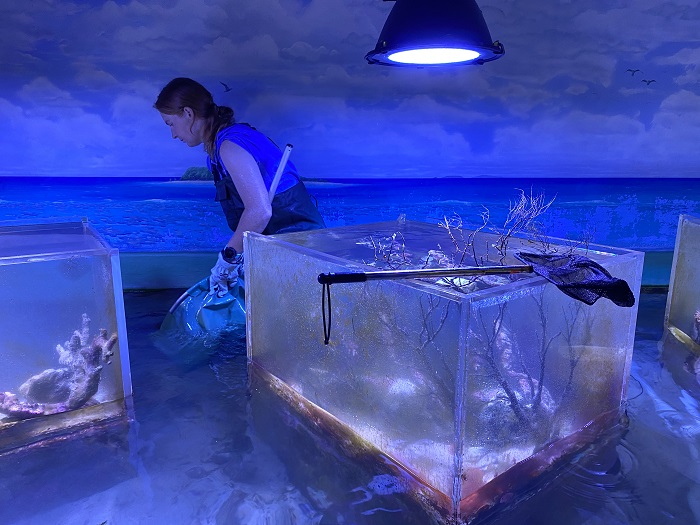
Great Barrier Reef Aquarium / Relocating the animals Since closing our curatorial team, who care for the animals and maintain their life support systems, have been destocking tanks and decommissioning exhibits. Some of the animals have been permanently placed in other aquariums, and some animals will be housed off site and returned once the works are complete. Animals that remain onsite at the Aquarium Many reef fish from the biodiversity tunnel exhibits, our seagrass tank, fisheries tank, and the foyer exhibits were relocated to our colours tank near the cafe, to refugia on the roof or into the coral reef exhibit, the world’s largest living coral reef aquarium. The first animal that delighted guests when they visited, was this magnificent anemone and the clownfish that called it home. The anemone has been “replanted” into our coral reef exhibit, and the clownfish remained with their home. Anemones have a muscular foot, also known as a pedal disc, that keeps them in place and also helps them move around the Reef. So, while we’ve “planted” this anemone, we may find it walking around with its muscular foot to explore its new home. Animals that have been relocated Due to the operational requirements when caring for animals, it was identified that during the transitional works, it was in the animals’ best interest to be relocated offsite. Aquarists worked with local stakeholders to relocate some of the visitor favourites. Our green tree python, Binda, meaning “green place” in a local Indigenous language was moved to Berserker Pythons. We were happy to hear that her transition went smoothly, as she has been eating well and even shed her scales. Green tree pythons are native to New Guinea and along the north-eastern coastline of Australia, adjacent to the Great Barrier Reef in Cape York. Our Ornate Crayfish have been rehomed with Ornatas where they will become dads as part of the breeding program at the Toomulla hatchery. Fun Fact: did you know a female lobster is called a hen and a male lobster is called a cock? Jellyfish were transferred to James Cook University, and shrimp were provided to the Australian Institute of Marine Science to assist in cleaning their tank mates. Our reptiles have been relocated to Billabong Sanctuary who will care for our saltwater croc, freshwater croc and freshwater turtle. Visitors to Billabong Sanctuary will be able to say “hello” to these familiar individuals within their new home and exhibits.
2022 Project update – October to December
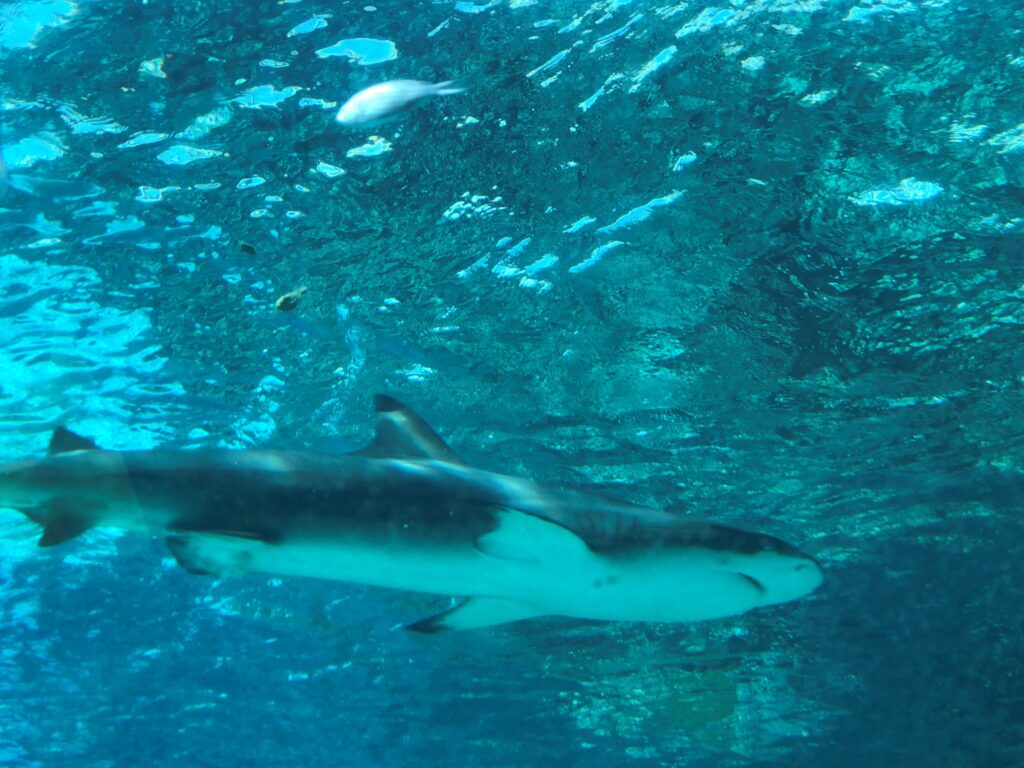
Great Barrier Reef Aquarium / Large fish destocking In October 2021, the aquarist and technical operations teams loaded the remaining animals from the predator tank onto the transport truck with huge success. The black tip reef shark, Queensland grouper, mangrove jack, surgeon fish and a large majority of the spiny chromis were transferred in a smooth and timely manner, concluding our destocking initiative. The team conducted thorough planning focused on the animals’ welfare. For example, two nets were modified with soft mesh to prevent injuries and assist with the catch strategy. Also, Stuart from the aquarist team was on hand when the animals arrived safe and sound at Sea World on the Gold Coast to oversee their unloading.
2021 Project update – July to September
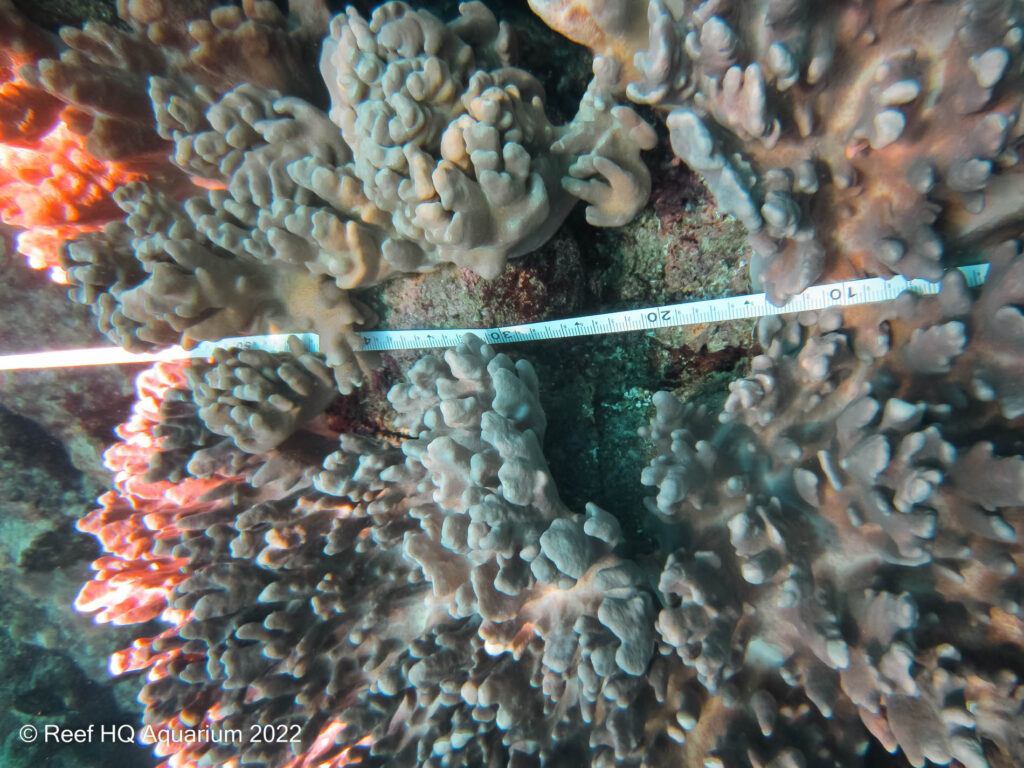
Great Barrier Reef Aquarium / Coral Reef Exhibit (CRE) Census In 2021, an analysis of the health of the Coral Reef Exhibit (CRE), a two million litre saltwater exhibit, was undertaken to ascertain a baseline before construction activities. The analysis took the form of a transect survey that quantified the composition of hard coral, soft coral, algae and other components found in the CRE. The project involved 5 transects, 100 photos, 850 data points and 1,600 metres of swimming. The survey results will assist to inform strategies to maintain the health of the corals during the works as well as to improve system condition and efficacy. Some of the photos taken as part of the survey can be seen below.
2022 Project update – January to March
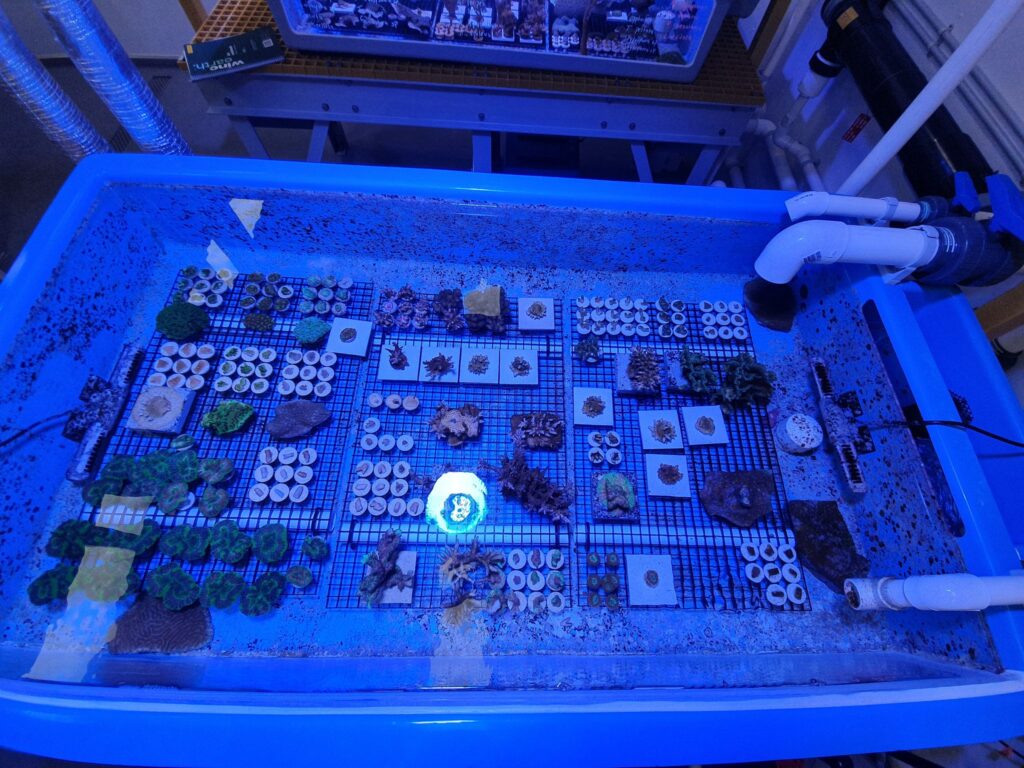
Great Barrier Reef Aquarium / Coral propagation The Aquarium’s aquarist and technical operations teams established an in-house coral propagation system to create a biobank of species that have been present in the Aquarium for several years. To emulate natural conditions, the system is running advanced life support systems, equipped with biological controls, foam fractionators, sand filters, UV filtration, circulator pumps, LED lamps, and coral dosing mechanisms to control and maintain water quality. The team are working with a wide range of coral species and to date there have been impressive growth rates across a large variety of Small Polyp Scleractinia and Large Polyp Scleractinia corals. Fragments of Acropora spp. have grown as much as 15 – 25mm per month. Animal relocation continues The destocking of most of the animals from the Aquarium has been achieved. Some animals have been, or will be, permanently rehomed in other facilities, and other animals will be temporarily housed off site and returned once the works are complete. Due to permitting requirements, no animals can be traded, sold, or released into the wild. A small animal holding area was constructed for animals that required relocation due to exhibit decommissioning. Staff from the curatorial team are onsite every day to care for the remaining animals. This includes feeding, tank maintenance and assessing the health and behaviour of the marine life.
2022 Project update April to June
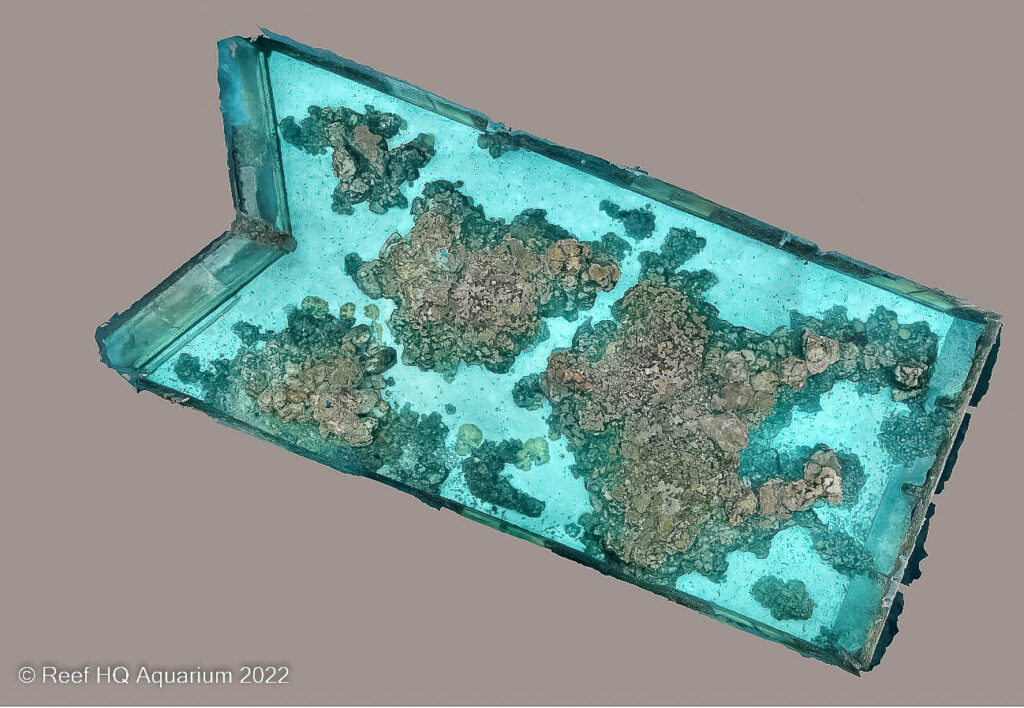
3D mapping of the Coral Reef Exhibit 3D mapping of the Coral Reef Exhibit (CRE) was carried out to allow greater understanding of the reef’s characteristics, including overall structure and morphology as well as abundance and distribution of the hard and soft coral. This information is being used to inform decisions about how best to care for and manage the living components of the CRE during the transformation. Click on the image below to see an interactive version of the 3D scan. This action will take you outside our website.
Master Plan
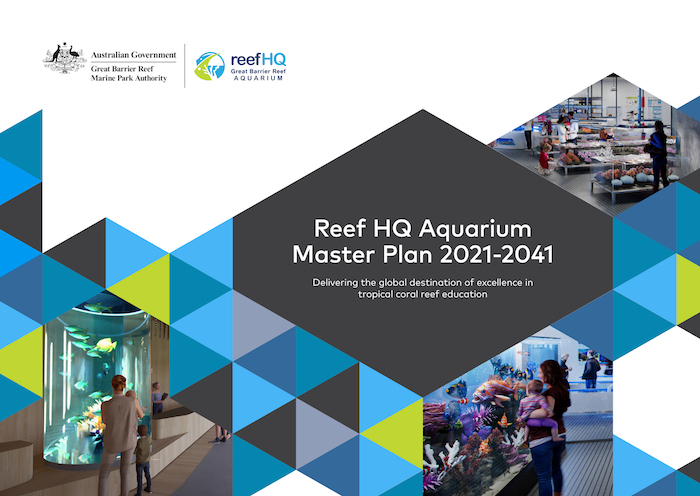
Great Barrier Reef Aquarium Master Plan 2021-2041 The Great Barrier Reef Aquarium established a Master Plan to guide long-term direction for continuous improvements and the objectives of the centre as a public institution for its long-term future. Master Plan vision The vision is to create a unified design character in order to sustain the Great Barrier Reef Aquarium as an educational and cultural landmark for visitors to North Queensland, well into the future. The Master Plan will direct the interpretive and functional master planning of the education, experience, and exhibits of the world-class Aquarium for the next 20 years. This Master Plan has been developed in two parts. Section one provides the context, strategic directions, and principles that guide the Reef Authority’s work and projects at the Great Barrier Reef Aquarium. This underpins the way we work and establishes a set of agreed directions that unify our common purpose and future direction. Section two outlines priority projects to be implemented in the next five years, as well as provides a conceptual guide for potential future developments. Master Plan main focus The main focus of the plan’s overarching vision is the establishment of a globally significant Reef Education Hub, which may include career pathway and traineeship programs, hands-on experiential learning areas and advanced coral propagation facilities as well as increased sustainability measures and enhanced technology to support learning throughout the new exhibits. Delivery of the full Master Plan will transform the Great Barrier Reef Aquarium as the global destination of excellence in tropical coral reef education and deliver on its commitment as the National Education Centre for the Great Barrier Reef. Located within Townsville’s Waterfront Priority Development Area’s Research and Tourism Precinct, the Aquarium is ideally placed to act as a vital centre of a world leading marine science precinct, showcasing Townsville’s reputation as a world leader in marine science, research and education. Master Plan download You can download a copy of the Aquarium’s Master Plan by clicking the link here (PDF, 6.7MB) or by clicking on the image below.
Life support system upgrades

Great Barrier Reef Aquarium / Life support system upgrades In May 2020, the Great Barrier Reef Aquarium received $2.6 million as part of the Government’s COVID-19 Relief and Recovery Fund to assist Great Barrier Reef Tourism and the North Queensland (Australia) regional economy. This investment was to upgrade life support systems throughout the Aquarium. Life support systems are crucial in maintaining temperature, salinity, filtration and water quality, ensuring optimum conditions for the care and welfare of our animals. Reverse osmosis machines Reverse osmosis in an aquarium removes salts and impurities from the water. Our system is a reverse osmosis machine, in that is concentrates the salinity in our tanks, which we require for our corals and marine life. It also displaces freshwater received through rain during the wet season. Our previous machine was installed in 2011 and could produce 9,000 litres per day. Each new system will displace 22,000 litres of freshwater per day, enabling one machine to remove around 70mm of rain from the coral reef exhibit per day. As we installed two reverse osmosis machines, the system can displace up to 44,000 litres per day! This has increased our previous capacity almost five-fold. During a significant rain event that occurred in Townsville (where the Aquarium is located) in 2019, our previous machine couldn’t maintain salinity levels or keep up with the 1500ml of that entered the coral reef exhibit. Staff were onsite and manually added 25 tonnes of salt to ensure salinity levels remained optimum. As corals are sensitive animals, a sudden decrease in salinity would have been catastrophic. The two systems were commissioned on Boxing Day in 2020. In the first three weeks of its operation, the Aquarium received 622ml of rain, equating to 390,000 litres of freshwater entering our coral reef exhibit (for perspective, this is the equivalent to just over half the predator tank). The new machine was running 24-hours a day. The salinity concentration over those 3 weeks didn’t drop more than 1 part, maintaining at, or close to, our optimal level of 35 parts per thousand. This is a testament to the equipment and upgrades to technology, which are essential to ensure our systems can keep up with consistent rainy days during our tropical wet season. One of the newly installed sand filters. Sand filters Sand filters are a mechanical filtration system that traps suspended particulates and removes them from the water, ensuring water clarity. Our previous sand filters were located in a gated area in Kelleher Place. These sand filters were at the end of their life and needed to be removed (or relocated) to allow space for a new Ergon Padmount transformer and a new fire hydrant booster pump. Our new sand filters have been installed (one in the in the generator room for the coral reef exhibit) and (two in the Glaciem Room for the predator tank), which are enclosed rooms on level one of the Aquarium, next to the predator tank. There were many challenges in the installation: The installation of the new system had to occur amongst numerous other related projects in a tight time sequence. The new system needed to be operational as soon as possible, so that the old system could be removed to provide space for the fire hydrant booster pump. However, the old system couldn’t be removed until the new one was tested and running correctly. The new sand filter system comprises many very heavy and bulky components, which were installed in a small space. The sand filters were moved three times using an A-frame lifter crane, to find the right fit with only a few centimetres to spare in the positioning of the equipment needed to operate them. To operate the sand filters there are 16 valves. We had to commission the creation of 3 one-of-a-kind PVC pipework fittings to direct the pipework in the correct direction neatly along the walls, which have unusual angles; the glaciem room where the predator tank sand filters are located is not a typical rectangle. To ensure the sand filters and pipework were clean and operating correctly, we conducted backwashes, which are a standard weekly operating procedure. When backwashing, we cannot afford to drain too much water from the predator tank, as we will expose the top of the acrylic windows, which can create other problems. Also, we have to be mindful of our water usage in the wet season, as Ross Creek, from where we intake water, is often at lower salinity concentrations than we prefer due to rain. Despite the challenges of installing the sand filters in the new location, the space is more secure and improved for staff who work with the equipment. The location also aids in improved efficiencies in the sand filter system as it is closer to the water source. This, coupled with highly durable and efficient pumps, minimizes energy use compared with the previous system setup. The sand filters are used to remove particulates from the water, by forcing water under pressure through micron media. In the case of our new sand filters, recycled glass. The glass simply catches or traps the waste particles, which helps with the water clarity by reducing the amount of particles floating around in the tanks. They also help catch particles before they settle on the bottom of the tanks. The two predator tank sand filters are holding 3150 kilograms of recycled glass media, while the coral reef exhibit sand filter is holding 2250 kilograms. We are using two grades or size of glass, coarse glass media (1.7mm to 3mm size pieces) and fine glass media (0.75mm to 1.7mm size pieces). Each of the three sand filters has the bottom 1/3 of the filter filled with coarse glass media and layered on top of the coarse media is an additional 2/3’s fine glass media. This sand filter system will be connected to our new thermal energy storage system, which uses ice to store energy and provides chilled water to cool the temperature in the
